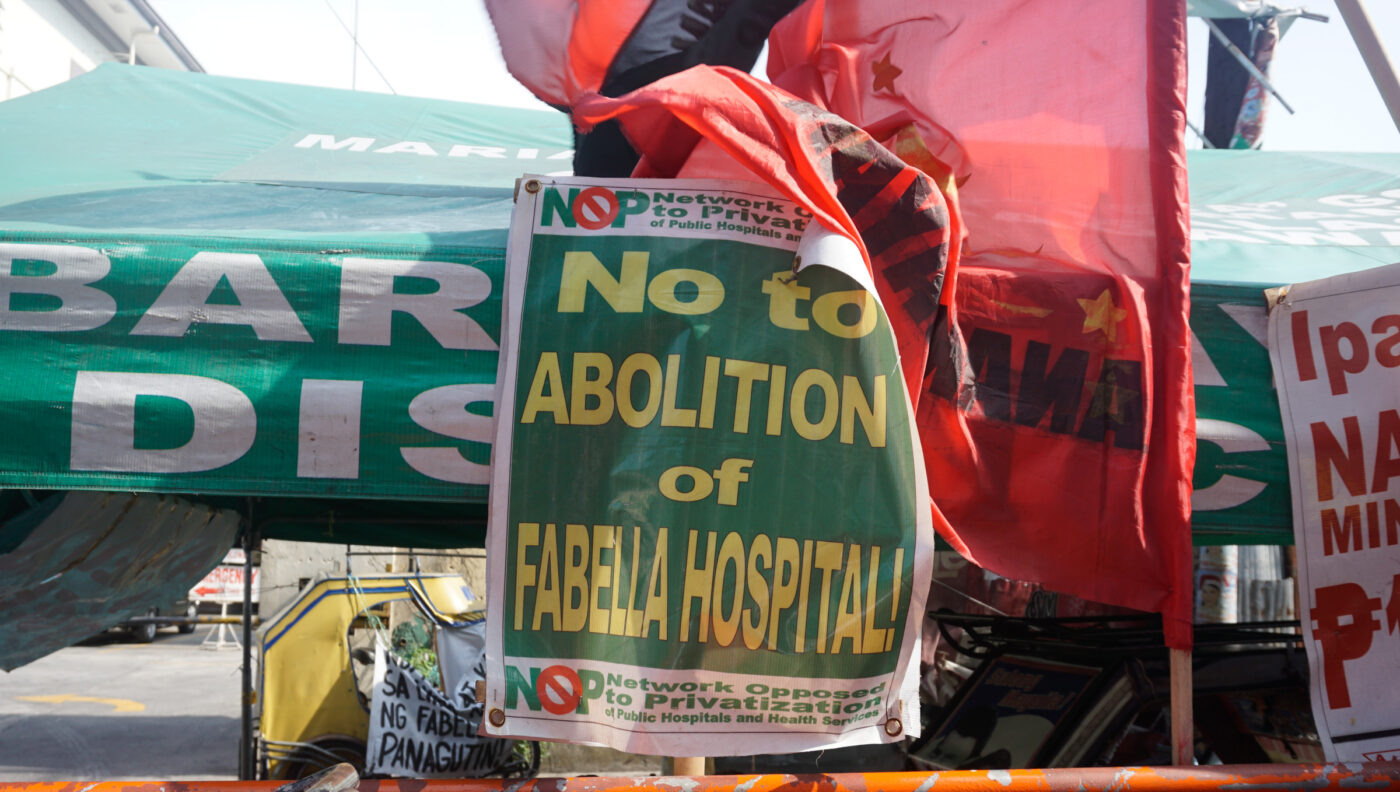In the heart of Manila sits the Dr. Jose Fabella Memorial Hospital, the country’s largest maternal and newborn medical facility. Because of its affordability, it is the most preferred and often the only source of maternal and reproductive care for many mothers, especially those from Metro Manila’s poorest areas.
“Marami talagang dumadayo dito. Mas mura kasi, kaya kahit malayo pinanggalingan, mas gusto na dito manganak. (Many people go here. It’s cheaper, so even if they come from far away, they prefer to deliver here),” says Gladys from Manila, as she watches her sister in labor. She said her sister moved to Fabella from a private hospital because of the latter’s lower costs.
Recently, the hospital has been the site of a drawn-out battle between administrators and groups composed of health workers and patients. The Alliance of Health Workers (AHW) has pointed to a demolition scheduled for June 9 as part of government efforts to close and privatize the hospital. In response, protests were held near the hospital and the Save Fabella Hospital Movement (SFM) was formed.
The Department of Health (DOH) has denied the claims. In a Rappler interview, former DOH Secretary Janette Garin said that “Fabella will not be closed. No employees will be terminated or displaced.” She said that instead, the DOH plans to transfer the hospital to a new building within the DOH compound in Manila. The demolition was also postponed.
“Dismal state”
In a petition, SFM declared that Fabella’s closure “[spells] a death sentence to the already dismal state of maternal and child health services [in the] Philippines.”
Fabella itself reveals this dismal state. Although its care programs have been recognized as “a role model” by the World Health Organization, its facilities and workers are inadequate given the demand. Up to 100 babies are delivered daily and it is not uncommon for mothers to share a bed with three others.
“Kapag charity ward ka, magtitiis ka talaga. May mga kahati ka sa kama, tapos di ka natututukan ng nurse kasi nga marami kayo. (When you’re in the charity ward, you have to bear it. You have to share a bed, and the nurse can’t keep an eye on you because you’re so many),” said Gladys.
The conditions in the hospital are indicative of a nationwide situation. According to Angelito Umali, MD, Maternal Health Adviser for the United Nations Population Fund, lack of health facilities and skilled health workers especially in isolated and disadvantaged areas, conflict-stricken areas, and indigenous communities challenge maternal health conditions.
“Seventy percent of health workers are working in thirty percent of the Philippines,” he said.
The high cost of health services has also been decried. AHW president Robert Mendoza told Rappler that the “prices for hospitals…still increased during [former] President [Noynoy] Aquino’s last year.”
Improving, but slow
Reports from government and international agencies such as the Millennium Development Goals Progress Report and the DOH Annual Report suggest that other important indicators on maternal health are not being met.
Particularly, the latest figures for maternal mortality ratio stood at 221 deaths per 100,000 live births, far from the target of 52. The latest contraceptive prevalence ratio of 48.9% was also below the targeted 63%.
Despite these challenges, Umali noted that there were major developments under the previous administration, particularly in the access to emergency obstetric care, number of facilities, and provincial penetration of health services.
Umali also lauded government measures such as increased family planning budgets, nurse and midwife deployment programs, and the administration’s supportiveness towards reproductive health efforts. He also highlights the Responsible Parenthood and Reproductive Health (RPRH) Law, which allowed for greater investments in reproductive health commodities and broader PhilHealth coverage for pregnant women.
However, he notes that significant challenges remain, primarily with the implementation of the RPRH Law. He says that legal issues, budget cuts, and problems at the local government level prevent full implementation.
Continuing struggle
In spite of the challenges, Umali is optimistic about the prospects of maternal and reproductive health under the new administration.
According to Umali, DOH Secretary Paulyn Ubial “saw the implementation of the RH Law. She’d know the challenges already. Now that she is at the helm, [the challenges] would be properly addressed.”
He also described President Rodrigo Duterte as “keen on addressing population issues.” In his State of the Nation Address last July 25, Duterte said that RPRH “must be put into full force.”
Health activist groups such as AHW share similar sentiments. The group was part of the progressive contingent that rallied in support of the new president on his inauguration on June 30. The group has also been in dialogue with Sec. Ubial.
As for Fabella, SFM posted that “The struggle to stop Fabella’s abolition continues” on their Facebook page. As of press time, the group has resumed protests in front of the hospital and will continue to do so until the safety of the hospital is guaranteed.




